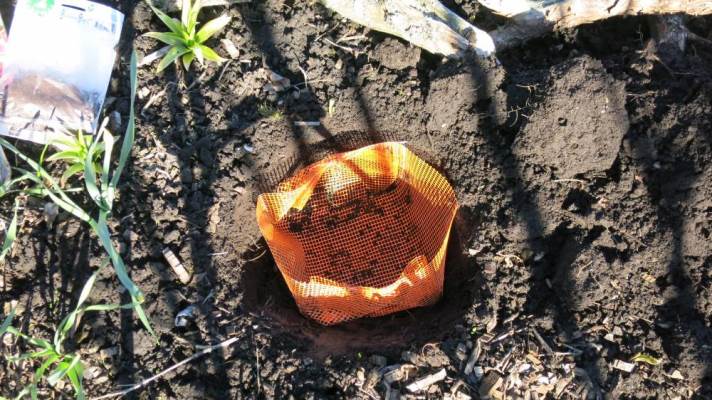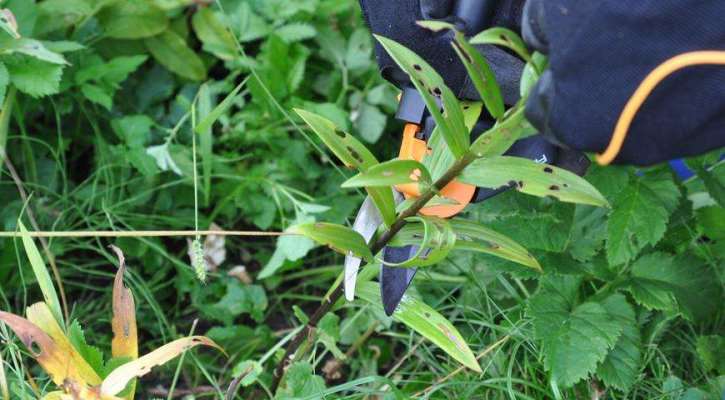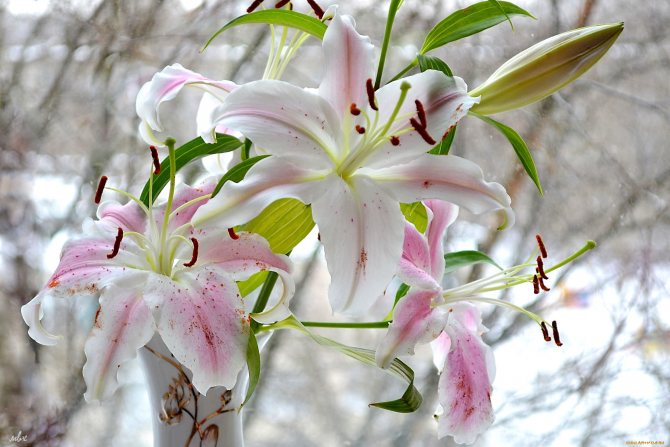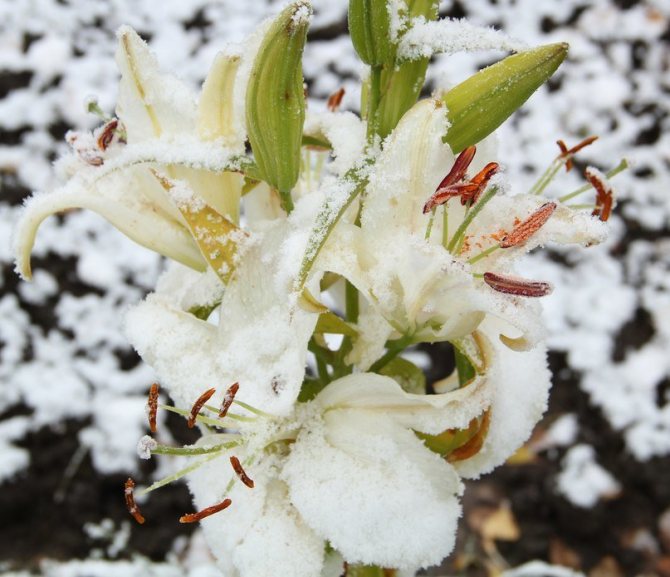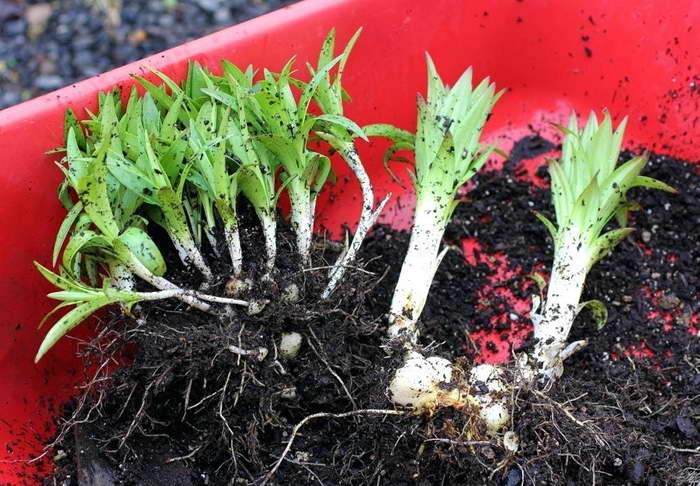Preparing lilies for wintering
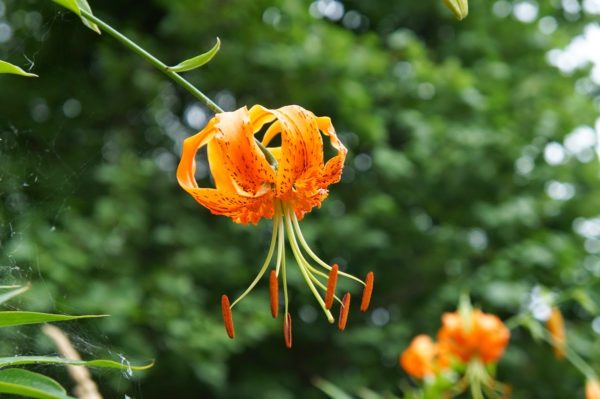
Varietal lilies do not tolerate low temperatures well, and are prone to freezing. If it is wrong to prepare the plants for winter in the fall, flowering will be scarce next summer. In winter, bulbs attract pests, and spring flooding promotes the development of rot. Therefore, even in warm regions, lilies need to be prepared for the arrival of cold weather. All activities should be completed by early October.
Autumn care for garden lilies includes the following procedures:
- pruning stems;
- mulching;
- fertilization;
- treatment against diseases and pests;
- covering the bulbs in the ground.
Pruning lilies
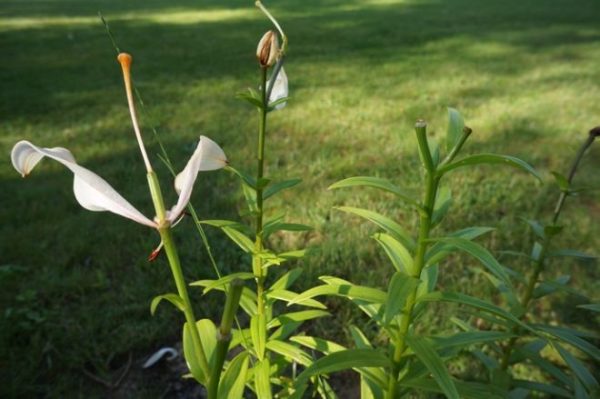

Lilies finish flowering around mid-July, and novice gardeners tend to prune them right away. Removing shoots too early will only harm the plants. Even after flowering, vital processes take place in their vegetative parts, as a result of which the bulbs grow and accumulate nutrients. Therefore, it is necessary to give the plants the opportunity to gain the strength that is necessary for frost resistance or rooting during spring planting. You need to wait for the shoots to die off on their own.
Important!
Do not leave lilies uncircumcised until spring. During wintering, harmful insects and pathogens can hide in the stems, which are activated in spring. Therefore, the cut parts of the plant are burned.
Pruning lilies for the winter is carried out in 2 stages:
- In August, the bolls formed instead of flowers are removed with pruning shears so that the plant does not waste energy on ripening the seeds.
- When the stems wilt and dry out, they are cut off near the ground. You can leave stumps up to 15 cm in height. Pruning time is from late September to mid-October.
Caring for flowers before and after pruning
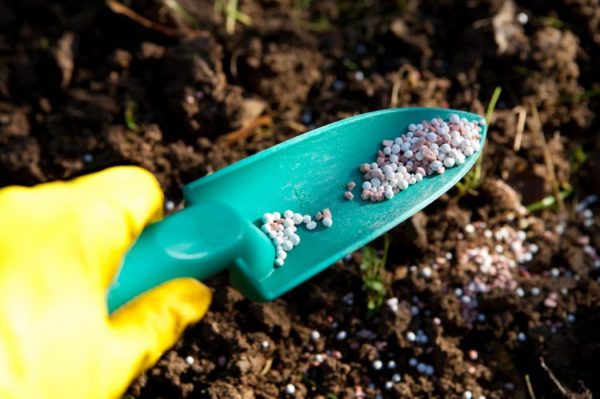

During the care of lilies in the fall, preparations are made for winter. When the plants have completely faded, they are fed with potassium-phosphorus fertilizers: the Kemira Autumn complex, superphosphate and potassium magnesium. Before fertilizing, the soil around the plants is well moistened so as not to burn the roots. Warm water should be used to prepare the top dressing. Fertilizer saturates the bulb with nutrients, restoring strength and preparing for winter. Such lilies are resistant to frost, and in spring they wake up faster.
In early September, they stop watering the flower bed so that the bulbs do not rot. Lilies need to be sprayed 2 times with a solution of copper sulfate. Preventive treatment will protect plants from fungal diseases in rainy weather. After trimming the bushes, a layer of compost or rotted manure with a thickness of 20 cm should be poured under each stump. Mulch will help warm the bulbs in winter, and in spring it will be an excellent organic fertilizer for awakened lilies.
Important!
In the fall, it is not recommended to feed the flowers with nitrogen-containing complexes, which are used in the spring to improve the growth of bushes.
Shelter lilies for the winter
Many types of lilies do not need much care in the fall. It is enough to properly cut and insulate them. Tiger lily, Asian and Oriental hybrids tolerate wintering well in beds without shelter in regions with mild, snowy winters. Flowers growing in the northern regions can freeze out. It is better not to take risks and cover the flowerbed with bulbs with thermal flooring.Such an event should be carried out before the onset of autumn frosts. The optimal dates are from mid-October to early November.
Shelter for bulbs wintering in the garden can be made from coniferous branches, sawdust, rotted foliage or spruce branches. In the northern regions, lilies are additionally covered with a special covering material, which can be purchased at the store. So that the coniferous needles fit snugly to the surface of the earth and do not scatter when the wind gusts, they are sprinkled with a layer of peat. The needles will protect the bulbs from slugs and harmful insects. In the spring, when constant heat is established, the shelter is removed. If removed too early, the sprouts may freeze during recurrent frosts. With a belated removal of the insulating material, the stems become thinner, and few flowers are formed.
Important!
Do not cover lilies with plastic wrap for the winter, because it prevents oxygen from reaching the bulbs, which can cause them to die.
Digging lily bulbs for the winter
In some situations, in order to save the bulbs from winter frosts in cold regions, it is not enough just to mulch and cover, you need to dig up the bulbs in the fall and send them for storage at home. And in the spring, plant them in open ground. Or you can transplant them for the winter in a greenhouse.
You need to dig for the winter:
- Bulbs American, Longiflorum, Oriental hybrids lilies.
- Bulbs exclusive and unique varieties of lilies, which do not have exact information about their resistance to frost.
- And you also need to dig it out annually Asian hybrids... They form many babies, so it is very important to dig up and separate the babies from the bulbs. Otherwise, the babies will grow very tightly to the mother's bulb, it will be difficult to separate them in the future. In this case, the children will take away nutrients, moisture, because of this, the plant will weaken, the flowering will be poor and inconspicuous.
After digging the bulbs of Asian hybrids, you need to immediately separate the babies, and plant the mother bulbs back in the open ground. And it is better to plant children in spring, in winter they need to be stored at home.
You need to dig up the bulbs for the winter according to the following scheme:
- The first step is the standard cropping.
- Then you need to water the flowerbed with plants in a day or 12 hours.
- After that, it is necessary to carefully dig the bulbs with a pitchfork, avoiding any damage to it and the root system.
- You need to get the bulbs out of the ground together with a lump of earth. After digging up, you need to inspect it for rot, damage. Severely affected specimens should be discarded.
- After that, you need to rinse the bulbs in cool water.
- All damaged and dead scales should be removed.
- Then you need to cut off all damaged and too long roots.
- It is recommended to carry out disinfection in a fungicide solution, for example, soak in a solution "Maxim Dachnik", "Karbofos".
- You need to completely dry the onions in a dark, dry place and send them to storage.
Store lily bulbs in winter in a cool, dark room with high humidity (at least 70%). The temperature should be around 6-8 degrees Celsius. The best way of storage is in a wooden box covered with paper, it is recommended to fill it on top with a mixture of peat and coniferous litter or rotted coniferous sawdust, and cover it with paper again. During storage, it is recommended to sometimes inspect them for signs of disease, rot, and mold. If signs are found, the affected specimens should be treated in a fungicide solution.
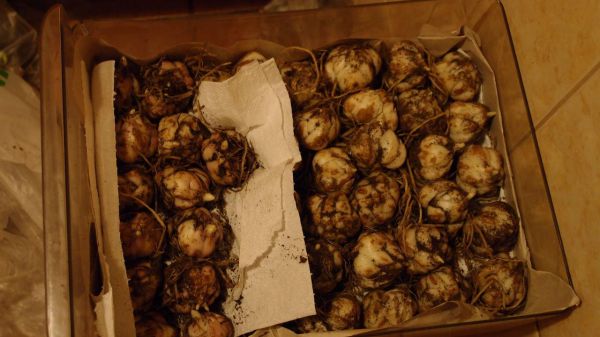

What varieties are dug up in the fall
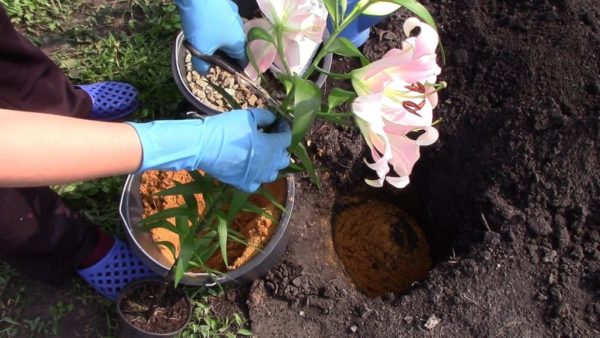

Wild and regionalized varieties of lilies winter well in the garden. They must be dug out 1 time in 3-4 years to separate the bulb and transplant to a new place. Otherwise, the plants thicken and the flowering becomes weak.Frost-resistant varieties are lightly sprinkled with covering material so that they do not freeze. Even harsh winters are not terrible for curly, dahurian and saffron lilies. In the southern and central regions, where winters are snowy and warm, the bulbs are transplanted to a new location during the autumn digging. You can leave the tiger lily, martagon, candidum and OA hybrids for the winter in the flowerbed.
But what about lilies growing in unsuitable climatic conditions? Exotic varieties susceptible to winter cold should be dug up in the fall. Otherwise, they will die at the first severe frost, even under cover. Do not leave oriental, tubular and American hybrids to winter in the flowerbed, because their bulbs freeze easily. Annual digging is required for Asian and LA hybrids. Otherwise, they will not bloom again. For such varieties, the formation of numerous children is characteristic. They take nutrients from the central bulb that are necessary for full flowering.
Disease prevention, pest control
Preventive treatments are carried out annually in spring and autumn. Pruning of plants partially solves the problem - spores of fungi, eggs and larvae that remain to winter on the stems are removed. It is also necessary to spray the "hemp" remaining from the lilies and the soil in the flowerbed with 2% copper sulfate, Bordeaux liquid or a solution of any fungicide (dosage and consumption rate are determined in the instructions).


For the treatment of lilies, you can use any fungicides - from long and well-known to gardeners of copper sulfate and Bordeaux liquid to modern preparations of biological origin
Of the pests of lilies, thrips, aphids, and a lily fly are most often attacked. Any general action insecticides - Mospilan, Spark Double Effect, Aktara will help prevent their appearance. The treatment is carried out 7-10 days after spraying with fungicides.
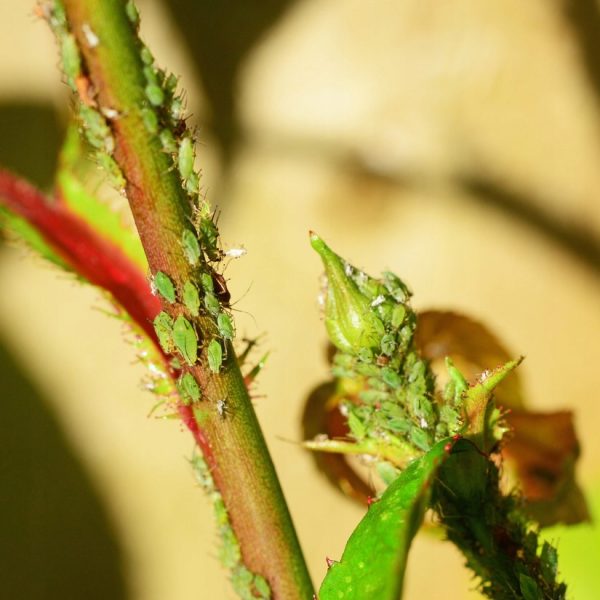

Aphids are distinguished by their rare "omnivorous", they attack almost any garden crops with whole colonies
When and how to dig up the bulbs


It is recommended to dig up lilies in the first decade of September. Each variety has its own term. The bulbs begin to be dug up when the plants have faded, turn yellow and wilted. After flowering, it should take 30-45 days for the lilies to fill in the nutrient deficiency and grow. Even if the plants have not withered before the beginning of October, they are still dug up for winter storage.
Important!
Lilies need to be transplanted before September 10, so that they take root before the first frost.
A garden pitchfork is suitable for removing lily bulbs from the ground. they do not damage the roots. Digging is carried out after cutting the stems. If the bulbs are going to be stored indoors until spring, a container or bag must be prepared in advance. The process of digging up lilies includes the following steps:
- First, the soil is well moistened.
- Shake off the soil from the dug out bulbs. Then they are examined for disease damage. If necessary, remove brown areas, and sprinkle the cuts with crushed coal.
- The formed babies are separated from the mother's bulb.
- Lilies are washed in water, then placed in a solution of potassium permanganate or karbofos for 40 minutes.
- To protect the bulbs from ticks, they are treated with a saturated soap solution, which is prepared from laundry soap and warm water.
- The disinfected bulbs are sprinkled with wood ash and sorted.
- The planting material is dried in a shaded place, cutting off the roots to a length of 7-10 cm.
Autumn care of lilies before and after pruning
In addition to pruning, in the fall, to prepare for winter, lilies require feeding and treatment for diseases.
Top dressing
Immediately after these perennials have faded, under them fertilizers should be applied, which include potassium and phosphorus. For example one can use potassium sulfate (potassium sulfate) and superphosphate, 30-40 grams per 1 sq.meter of a bed or flower bed, or a special ready-made mineral fertilizer marked “Autumn ". For lovers of organic farming, suitable bone meal (phosphorus) and wood ash (potassium), 100 grams per 1 sq. meter.


Important! However, you cannot use ash for lilies, which do not tolerate alkalization of the soil, and these are varieties such as "Oriental", "Asian", "American", "LA-hybrids".
Such a potassium-phosphorus fertilizing will allow the plants to mature by the onset of winter, recuperate after abundant flowering and prepare for the onset of cold weather. These fertilizers will allow the root system to receive a large amount of nutrients and better withstand cold weather, as well as in the spring will make it possible to grow faster in the aerial part of the flowers.
A layer of decayed foliage or compost should be added under those lilies that will not be dug out for the winter. (the thickness of such a layer should be at least 15-20 cm). This fertilizer will serve as a kind of "blanket" for the roots and their additional protection from the impending frost. And in the spring, humus will be a good fertilizer and mulch for lilies.
This shelter is suitable for long-flowered, oriental and American hybrids.
The main feeding is over, but the care of flowering perennials continues.
Disease treatment
This is followed by a couple of times sprinkle the lilies with copper sulfate or Bordeaux liquid... Such treatment will protect the plants from possible diseases during the rainy season.
Watering
Already from the end of summer, that is, from about mid-August, it is recommended to exclude watering of lilies altogether, because the bulbs can simply get wet due to the abundant moisture.
How to store bulbs
Before being sent for storage, the bulbs are divided into large and small specimens. They are placed in a dark, ventilated place. The optimum temperature is 0 ... + 5 ° С. Such conditions do not allow the bulbs to germinate ahead of time. Lilies can be stored in the basement, and in urban settings - on the loggia or in the refrigerator. Once you have dug up lilies, you can plant them in flower pots. They are placed in a cool, bright place. The soil is moistened as the top layer dries. When it gets warmer outside, the bulbs are planted in the garden.
On a note!
In the refrigerator, lilies should be kept separate from vegetables and fruits to avoid the negative effects of plant ethylene gas.
Some growers use a dry wintering method, while others prefer a wet one. In the first case, the bulbs are sprinkled with dry soil and covered with a water-repellent material. The soil is slightly moistened 2 times a month. If mold is detected, the bulbs are treated with a solution of potassium permanganate. In the second method, lilies are folded into an oilcloth bag filled with wet peat or sand. You can put the bulbs in a plastic container with wet shavings or moss. The containers are closed with a lid, in which holes are made in advance for air circulation. Lilies overwintering indoors require planting and care.
Do lilies need to be pruned after flowering?
Unfortunately, every garden has a colorful flowering period. The petals fall off, only the seed capsule and the trunk with leaves remain. The presence of such trunks, not distinguished by their beauty, forces many to take up the pruner. Faded lilies stand out especially if other plants are not blooming nearby (for example, Turkish carnation). Summer residents and gardeners have several opinions about whether to prune lilies after flowering.
For this perennial, summer and even the beginning of autumn is the time to gain as much strength as possible. Throughout the summer, this plant strengthens and grows the bulb so that it does not freeze in winter. If you cut off the stems of a flower after flowering at the root, then the bulb will not gain enough strength for winter.
.
The fact is that green stems and leaves undergo photosynthesis both during the flowering period and when the lilies have faded. This chemical process, which is produced by green plants, oxygenates the bulbs and roots of the perennial. It is photosynthesis that allows perennial plants to wait out the winter for a long time and successfully and delight caring gardeners with beautiful flowers all next summer. Therefore, pruning after flowering will not help the grower in any way to care for the plant.
... As the saying goes, get your sleigh ready in summer.
Based on the above, we can conclude when to prune lilies after flowering. It is recommended to prune lilies after flowering, when the last petals have fallen and after a couple of days cut only the seed pod
... And so that you are not embarrassed by the protruding stems of faded lilies, plant other flowers in an ensemble with them. For example:
By planting flowers that bloom at different times (beginning, middle, end of summer and even autumn), the gardener gets an ever-flowering exquisite flower bed.
The main mistakes of amateur flower growers
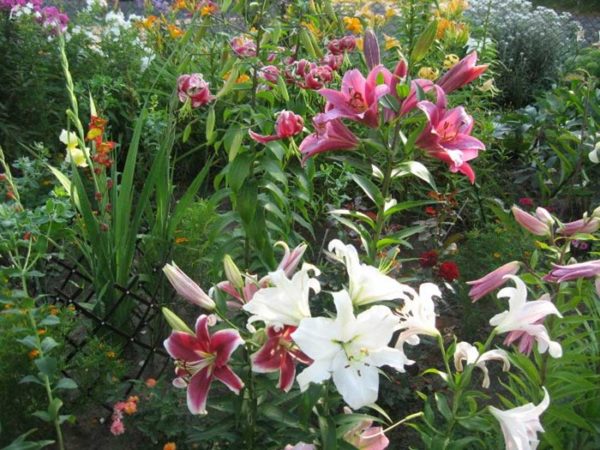

Lily is a beautiful flower that needs high quality care during the entire growing season. Novice florists often make the following mistakes:
- Fertilizers are not applied in the fall, considering that only flowering plants need to be fed.
- Cut off the stems early or forget to cut the lilies for the winter.
- Do not dig up varieties of lilies that are prone to freezing.
- The formed children are not seated.
- Wrongly cover flowers for the winter.
- Do not adhere to the deadlines for removing the shelter in the spring.
In order not to lose valuable specimens, it is necessary to properly prepare the lilies for the coming winter. Given the characteristics of the variety, each gardener decides for himself whether to dig up flowers in the fall or provide them with proper shelter. But do not forget about the timely separation of the bulbs. Therefore, experienced florists annually sort out the planting material and create favorable storage conditions for it until spring.
What can and can not be fertilized lilies in the fall
As for the composition of fertilizers, first of all, they must contain components such as phosphorus and potassium.
- Phosphorus is actively involved in the process of photosynthesis, delivering the necessary nutrition through the leaf plates, has a beneficial effect on the development of the root system, and allows flowers to form a large number of large buds.
- Potassium serves to strengthen the immunity of lilies, their resistance to the vagaries of the weather, lack of moisture. In a plant that is deficient in minerals, the development of the aerial part slows down, the leaves turn yellow along the edge, curl.
To replenish the need for phosphorus and potassium, you can use fertilizers such as superphosphate, potassium sulfate, potassium magnesium. Ready-made compositions for feeding lilies in the garden in autumn are also on sale. Florists for bulbous flowers, universal fertilizer "Autumn", is excellent for this purpose.
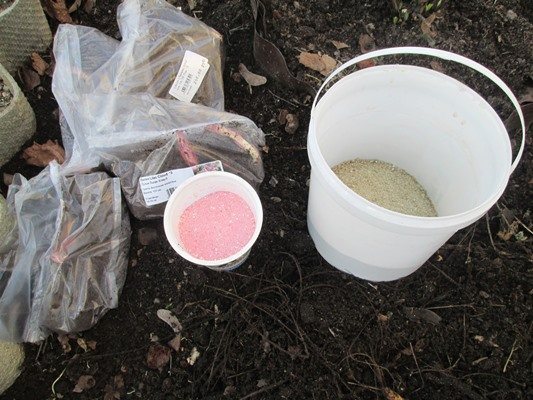

Attention!
A large amount of phosphorus is contained in wood ash, to the introduction of which all varieties of lilies respond positively. Wood ash also significantly reduces the acidity of the soil. It should be used with caution for feeding OT, LA and LO hybrids that prefer to grow in slightly acidic areas.
From folk remedies, it is worth noting the introduction of bone meal into the soil in clubs where lilies are grown. It contains a lot of potassium.
As for organic fertilizers, they are applied in late autumn, most often in dry form. Rotted manure, bird droppings or humus are used.
It is categorically impossible to use fresh organic matter. Feeding lilies in autumn with manure can lead to root burns, and next year cause a rapid growth of green mass to the detriment of flowering. In addition, fresh manure is a source of a large number of diseases. The larvae of the wireworm and the bear hibernate in it.Last spring can cause great damage to flowers in flower beds.

